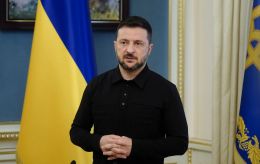Under siege from the sky: Brutal reality of Russia's attacks on Ukrainian Dobropillia
 A resident of Dobropillia (Photo: Anastasiia Rokytna/RBC-Ukraine)
A resident of Dobropillia (Photo: Anastasiia Rokytna/RBC-Ukraine)
How the town of Dobropillia near Pokrovsk is suffering under Russian attacks, why the enemy has chosen it as its new target, and what residents and soldiers are saying about the war — all in the report by RBC-Ukraine.
Russian forces have intensified their offensive in the Pokrovsk direction, particularly targeting towns that were previously considered relatively safe rear areas. Dobropillia, where just a month ago people were freely walking to shops, is now facing intense assaults from FPV drones and airstrikes.
On the way to Dobropillia
Early July. The heat presses down as if someone has thrown a heavy, burning blanket over the steppe. Meteorologists are already recording the year's highest temperature, but here in the Pokrovsk district of Donetsk region, few seem to care. We're driving with the snipers of the Rubizh brigade. The closer we get to the front line, the more frequently we see anti-drone nets stretched above the roads – a precaution to protect movement from enemy "birds."
Inside the vehicle, there's a chase of its own: Dandy tries to bite into a piece of fresh bread when Hora hits the gas, throwing him back into his seat. The bread remains intact, and Dandy gives Hora a mildly reproachful look, but both understand the need for haste.
Dandy is a young, kind-eyed guy from Zakarpattia who committed himself to military service a few years ago. He has a special connection with the animals that visit the unit's base. Back home, he keeps an entire zoo, including dogs, cats, parrots, and even hedgehogs. Having just returned from the front line, he instinctively tenses at any sound from the sky. On the battlefield, those sounds signaled that the enemy was trying to kill him, and he’s developed a heightened sense of danger.
While we were traveling on what seemed to be a relatively safe road, one of the soldiers warned us: Russian FPV drones had recently struck two vehicles on this same route. So we picked up the pace, trying to get there in one piece — and not burst into flames from a Russian FPV “bird.”
 Russian forces are relentlessly shelling Dobropillia
Russian forces are relentlessly shelling Dobropillia
As we approach the nearest town, we find ourselves at the center of events — explosions are rocking central Dobropillia. Around us, cars make frantic maneuvers, and frightened locals scan the sky, bracing for the next strike. Medics rush to carry out a seriously wounded woman. Their ambulance speeds away, as white vehicles with the "Star of Life" are a favorite target for the Russians.
Sirens pierce the air. One of the soldiers shouts to his comrades:
— Let’s go! Another FPV drone is incoming!
A kamikaze drone sounds like a giant insect — a distinct buzzing that can’t be confused with anything else. And even far from the front lines, that sound acts like a trigger. A regular mosquito or the roar of a motorcycle engine can make someone flinch.
We move on to another settlement where a sniper group is based. We're greeted by a young commander with the call sign Dobrynia. A wide smile, a traditional Cossack topknot, and a pipe in hand — he's a mix of humor and sharp command presence.
— They've started tormenting Dobropillia. It's never been like this before. Today's the first time they're hitting it so hard, — he says.
Indeed, on July 9, residents experienced the most intense attack since the war began. More than 70 strikes from Russian FPV drones were recorded in a single day. Their approach was interrupted by bursts from anti-drone rifles. Many of the copters were successfully shot down — the burning wreckage of Putin's drones fell short of their targets.
According to analysts from the Institute for the Study of War, after setbacks near Toretsk, Russian command shifted its focus and began concentrating forces on advancing from Novoekonomichne toward Dobropillia.
 Despite the shelling, people still live in the town
Despite the shelling, people still live in the town
ISW believes the enemy may now attempt to break through to Rodynske, which lies on the outskirts of Dobropillia. Their goal is to force Ukraine's armed forces to retreat from Pokrovsk and Myrnohrad under threat of encirclement. But Ukrainian troops are holding the line confidently, even as the front is increasingly frozen.
The reason for this freeze lies in the rapid development and mass deployment of drones. FPV strikes are becoming more effective than traditional "kings of war" like tanks. Everything now hinges on the need for new forms of defense — without them, armored personnel carriers, artillery, or even ordinary cars become easy prey for a small drone.
A week later
July 16. Just another day in the Dobropillia community, the sun scorching just as fiercely. Everything appears normal, like in any July town where public transport still runs and there are queues at the pharmacy.
Local Telegram channels — usually the first to report "birds in the sky" — are silent today. The town center is alive. People walk by with shopping bags; someone is carrying a melon, someone else a bottle of water. Cars crawl in both directions, with a cyclist weaving between them. The workday is ending. The air smells of dust and hot metal.
Inside a small shop, it's dim. Flies buzz against the window. The shopkeeper sits next to a crate of cucumbers, brushing insects off them from time to time. Her gaze is sharp, slightly wary.
— Have you been here long? Haven't seen you before, — she asks me.
— No, I arrived recently.
— Are you military?
— No, I'm a journalist.
— Oh, it's already so uneasy here. I keep working while I still can. But I'm afraid it'll hit here too, — the woman says, and wishes me, "Take care of yourself."
Her children left for abroad long ago. She stayed. Not because she couldn't leave, but because "someone has to be behind the counter."
Nearby, the store Avrora is still open — a place where women escape for an hour: from the heat, from war, from reality. They touch jars and towels with their fingers, as if they have choices. At the checkout, the clerks offer a weary "goodbye," having become used to measuring time not in hours until their shift ends, but in pauses between air raid sirens.
And while someone counts receipts, and others count the days until evacuation, a Russian KAB (guided bomb) is already counting minutes. It doesn't ask who's in its path — a child or a shopkeeper at Avrora — it simply flies.
At that very moment, we're in the town center with a group of soldiers. Among them is Oleh, a reconnaissance fighter from a special unit. He has been serving in the Ukrainian army since 2014 and knows the Donetsk region like the back of his hand. He no longer holds onto big hopes or faith — he simply does his job, staying in the army more "for the guys than for the state."
 Few intact neighborhoods remain in the town
Few intact neighborhoods remain in the town
We're talking about recent statements from US President Donald Trump. Ukraine is supposedly set to receive billions in military aid. The soldiers sigh skeptically. They've only heard talk of these promises — meanwhile, they keep working with what they have.
— And that…, — one soldier starts to ask me when a powerful explosion goes off.
In the first second, I turn my head toward the epicenter and see fire and black smoke. In the second, I drop to the ground behind the soldiers and cover my head with my hands. Nearby — shattered glass, chunks of metal, and debris from collapsed buildings. It's too dangerous to get up right away — there could be a second strike. These few seconds of lying still feel like an eternity.
We hear sirens — ambulances and fire trucks speeding through the smoke to rescue the wounded. The head of Donetsk Regional Military Administration, Vadym Filashkin, calls the strike "another horrific crime by the Russians" and urges civilians to leave the city. According to initial reports, four people were killed in the airstrike, and another 27 were injured.
Locals run out of buildings, put their phones in their pockets, and freeze in the middle of the road.
— Where?! Where did it hit?! — a woman cries out, clutching her hands together. Her voice carries fear that the strike might have hit close by. Or even closer.
Downtown Dobropillia is a hub where life intersects: markets, stores, pharmacies. It's a small town — everyone knows someone who could've been nearby during the explosion. Here, strikes aren't just headlines — they're the real threat of losing a friend, a neighbor, or that same produce shopkeeper.
— We saw it flying, so straight and high. Thought it’d pass over. But then it suddenly dropped down and boom, — says another woman who came out of a nearby building.
The air still smells of dust and burnt plastic. The sound of sirens mixes with people's screams. It's yet another tragedy for Dobropillia, which has become Putin's next target.
Why has Russia started terrorizing it so actively? Ihor Lytvynenko, a soldier from the 32nd Mechanized Brigade working in the area, explains that by striking Dobropillia, Russians are trying to push back the Ukrainian Defense Forces and advance toward the Dobropillia–Pokrovsk highway.
"Their main goal now is to encircle Pokrovsk. They don't want to attack head-on — it would be bloodier, with greater losses. And urban combat: look at Bakhmut, Toretsk — that's a year or more of fighting in a city, with no guarantee they'll capture it. But the city would be destroyed. Encircling it means they can take it more or less intact — like Selydove, which they got practically for free, and it's still relatively whole by wartime standards," he told RBC-Ukraine.
 Locals have effectively become targets
Locals have effectively become targets
The Ukrainian army is significantly smaller than Russia's, so it relies on more calculated strategies on the battlefield. Still, resources remain a serious issue. Russia is fighting with full state orders for drones, and a constant flow of freshly mobilized infantry from its so-called "human reserve."
The enemy's tactics have changed. The "human waves" appear less frequently now — instead, small groups move along the flanks, quietly, avoiding unnecessary noise. They steer clear of cities, sneaking through fields. The main striking force of the enemy has become the relentless FPV drone attacks, some of which are now directed at Dobropillia — considered a logistics hub.
Still, what kind of logistics a civilian store like Avrora is involved in — along with nearby shops selling vegetables, baked goods, and clothing — remains a rhetorical question for us. For the enemy, however, it's just another "military decision-making center."

